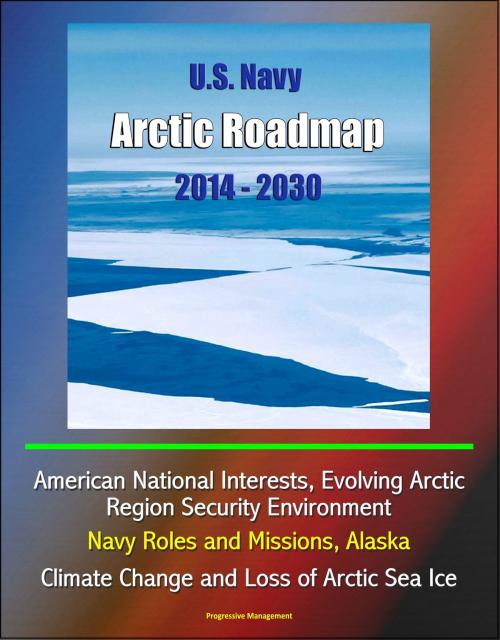U.S. Navy Arctic Roadmap 2014: 2030: American National Interests, Evolving Arctic Region Security Environment, Navy Roles and Missions, Alaska, Climate Change and Loss of Arctic Sea Ice
Nonfiction, History, Polar Regions| Author: | Progressive Management | ISBN: | 9781311633200 |
| Publisher: | Progressive Management | Publication: | November 18, 2014 |
| Imprint: | Smashwords Edition | Language: | English |
| Author: | Progressive Management |
| ISBN: | 9781311633200 |
| Publisher: | Progressive Management |
| Publication: | November 18, 2014 |
| Imprint: | Smashwords Edition |
| Language: | English |
The U.S. Navy recognizes that the opening of the Arctic Ocean has important national security implications as well as significant impacts on the U.S. Navy's required future capabilities. The national security interests of the United States, an Arctic nation through the state of Alaska, extend into the entire Arctic Region. The United States has a history of maritime homeland security and homeland defense concerns in the Arctic Region along with a longstanding North American security partnership with Canada. The U.S. Navy, with its long track record of Arctic Ocean operations and exploration, is planning today to address future Arctic Region security concerns.
The establishment of Navy's Task Force Climate Change and the U.S. Navy's 2009 Arctic Roadmap were important steps gaining a comprehensive, unambiguous understanding of the complex environment of the Arctic Region and the many challenges it poses for future operations. Today, the observed changes in the Arctic Region climate and the reduced extent of summer sea ice reveal the potential for the Arctic Ocean to become a more viable route for international shipping over the coming decades. Opportunities exist for infrastructure development and commercial investment, resource exploitation, fishing, and tourism.
In the coming decades, the Arctic Ocean will be increasingly accessible and more broadly used by Arctic and non-Arctic nations seeking the Region's abundant resources and trade routes. Due to the significant retreat of sea ice, previously unreachable areas have started to open for maritime use several weeks each year. The predicted rise in oil and gas development, fishing, tourism, and mineral mining could alter the Region's strategic importance as Arctic and non-Arctic nations make investments. Despite this gradual ice opening, the Region's frequent harsh weather and sea conditions are significant limiting factors for Arctic Ocean operations.
This update of the 2009 Navy Arctic Roadmap provides guidance necessary to prepare the Navy to respond effectively to future Arctic Region contingencies, delineates the Navy's leadership role, and articulates the Navy's support to achieve national priorities in the Region. Navy functions in the Arctic Region are no different from those in other maritime regions; however, the Arctic Region environment makes the execution of many of these functions much more challenging.
The U.S. Navy recognizes that the opening of the Arctic Ocean has important national security implications as well as significant impacts on the U.S. Navy's required future capabilities. The national security interests of the United States, an Arctic nation through the state of Alaska, extend into the entire Arctic Region. The United States has a history of maritime homeland security and homeland defense concerns in the Arctic Region along with a longstanding North American security partnership with Canada. The U.S. Navy, with its long track record of Arctic Ocean operations and exploration, is planning today to address future Arctic Region security concerns.
The establishment of Navy's Task Force Climate Change and the U.S. Navy's 2009 Arctic Roadmap were important steps gaining a comprehensive, unambiguous understanding of the complex environment of the Arctic Region and the many challenges it poses for future operations. Today, the observed changes in the Arctic Region climate and the reduced extent of summer sea ice reveal the potential for the Arctic Ocean to become a more viable route for international shipping over the coming decades. Opportunities exist for infrastructure development and commercial investment, resource exploitation, fishing, and tourism.
In the coming decades, the Arctic Ocean will be increasingly accessible and more broadly used by Arctic and non-Arctic nations seeking the Region's abundant resources and trade routes. Due to the significant retreat of sea ice, previously unreachable areas have started to open for maritime use several weeks each year. The predicted rise in oil and gas development, fishing, tourism, and mineral mining could alter the Region's strategic importance as Arctic and non-Arctic nations make investments. Despite this gradual ice opening, the Region's frequent harsh weather and sea conditions are significant limiting factors for Arctic Ocean operations.
This update of the 2009 Navy Arctic Roadmap provides guidance necessary to prepare the Navy to respond effectively to future Arctic Region contingencies, delineates the Navy's leadership role, and articulates the Navy's support to achieve national priorities in the Region. Navy functions in the Arctic Region are no different from those in other maritime regions; however, the Arctic Region environment makes the execution of many of these functions much more challenging.















